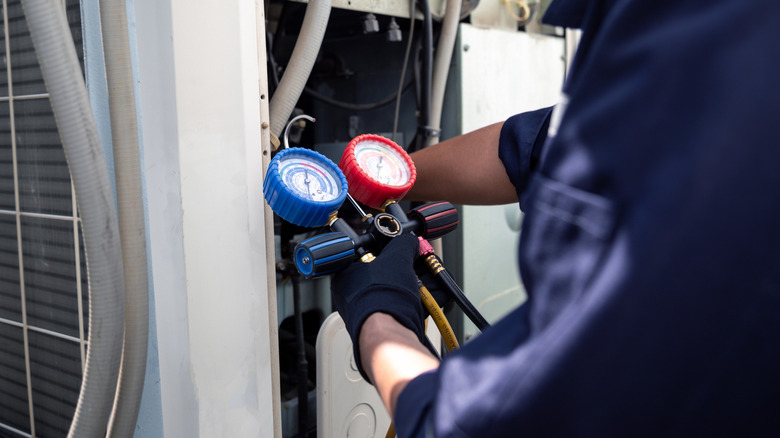Scientists Invented A New Refrigerator Cycle That Changes Everything
Scientists have invented a new form of refrigeration technology called ionocaloric cooling that's purportedly safer and better for the planet. It utilizes the way energy is stored or released during phase changes, with a bit of salt thrown into the mix. To understand, it helps to have a basic overview of how current systems work. It doesn't matter whether you're talking about a refrigerator — the most disruptive technology of the last century — or an air conditioning system, they make use of fluids called "refrigerants" to manage temperature. A refrigerant basically moves thermal energy from one component to another, absorbing or releasing heat through phase changes, like when an element changes from a solid to a liquid or a liquid to a gas.
In an air conditioner, the refrigerant produces cold air through a multi-stage cycle of compression, condensation, expansion and evaporation. The cold air is produced by blowing air across an evaporator coil where the refrigerant is converted from a liquid to a gas. That phase change absorbs ambient heat, causing the air to cool. That gas is then passed through a compressor, raising its temperature and pressure, before being shuffled along to a condenser where it returns to a liquid state, releasing its heat (this is the big fan you see outside of houses). That cooled liquid is then recycled back to the evaporator where the process is repeated.
This is what refrigerants like Freon are used for. Unfortunately, these substances, which are often synthetic and contain hydrofluorocarbons, are also bad for the environment, especially when used in concentrated amounts. The new technology works similarly, but uses salt or "charged particles" to rapidly force phase changes from solid to liquid.
How does the new technology work?
This new technology works just like refrigerants in use today, only with a slight twist. Instead of using pressure to induce phase changes between liquid and gas, this system uses ions to force phase changes from solid to liquid. As described in the journal Science, the process uses ethylene carbonate as the refrigerant, then adds ions in the form of salt made from sodium and iodine to melt it, reducing ambient temperatures. This step is analogous to the evaporator in a traditional A/C system. That heat can be removed from the refrigerant by desalinating it (removing the ions), causing it to solidify, releasing its heat similar to a condenser.
The ethylene carbonate refrigerant is particularly intriguing because it's produced using CO2, meaning it has a negative global warming potential (GWP). Normal refrigerants can release pollutants during maintenance, leaks, standard operation, or when disposed of, but this new method would significantly reduce that risk.
While this new technology is promising, more needs to be done to quantify its benefits. Ravi Prasher from Lawrence Berkeley National Laboratory, said in a press release that the data from their initial tests "looks very promising." From here, the technology needs to be made for the real world versus lab testing while also being scaled up for commercial use. The researchers believe the technology could eventually be used for both heating and cooling. That's a big deal. Sure, modern refrigerators or A/C units are safer because of newer laws, with restrictions on the chemicals used, but this new technology could significantly alter those concerns by eliminating harmful refrigerants altogether. Between these new methods and eco-friendly technologies to help remove toxic forever chemicals from water, we may soon be able to clean up the planet a little better.

